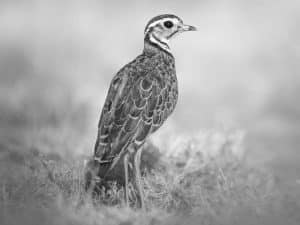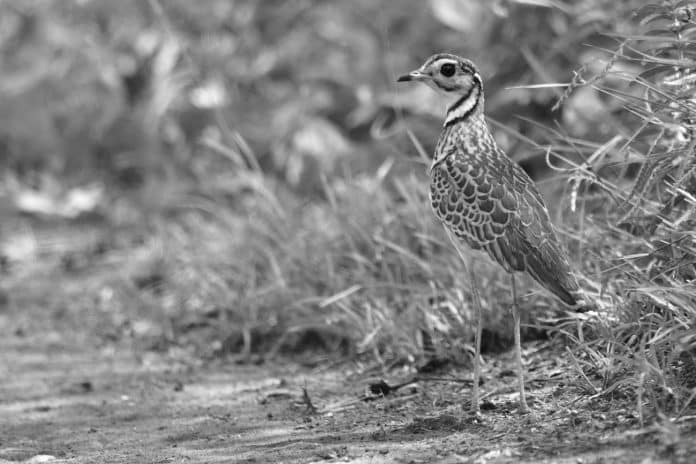Introduction to the Three-Banded Courser
Tanzania is home to a mesmerizing array of wildlife, and one of its most fascinating creatures is the elusive Three-Banded Courser. This small, ground-dwelling bird is known for its unique adaptations and remarkable life cycle. In this article, we will delve into the world of the Three-Banded Courser in Tanzania, exploring its habitat, physical characteristics, feeding habits, breeding behavior, and more. Join us on this journey as we unravel the secrets of Tanzania’s nighttime nomads.
Habitat and Distribution of the Three-Banded Courser in Tanzania

The Three-Banded Courser can be found in various regions of Tanzania, making its home in the country’s diverse landscapes. From the vast Serengeti plains to the arid deserts of the Maasai Steppe, these birds have adapted to thrive in different habitats. They are particularly fond of open grasslands, savannas, and semi-arid areas with sparse vegetation. Their ability to camouflage themselves among the sandy soils and dry vegetation is truly remarkable.
Physical Characteristics and Adaptations of the Three-Banded Courser
The Three-Banded Courser is a small bird, measuring about six to seven inches in length. Its most distinctive feature is its three black bands that encircle its chest and belly, giving it its name. These bands serve as excellent camouflage, blending seamlessly with the surrounding sandy environment. The plumage of the courser is mainly sandy brown, further aiding in its concealment from predators and potential prey.
One of the most remarkable adaptations of the Three-Banded Courser is its ability to regulate body temperature. During the scorching daytime temperatures, these birds lower their body temperature to conserve energy, entering a state of torpor. This unique adaptation allows them to survive in the harsh conditions of their habitat.
Feeding Habits and Diet of the Three-Banded Courser
The Three-Banded Courser is a nocturnal bird, primarily active during the night. It has specialized adaptations that allow it to navigate and hunt in low light conditions. These include large eyes with excellent night vision and sensitive hearing.
The diet of the Three-Banded Courser consists mainly of insects. They have a particular affinity for beetles, spiders, and scorpions. With their sharp beaks and agile movements, they expertly capture their prey, often using stealth as their primary hunting strategy. Their ability to snatch insects from the ground with lightning-fast reflexes is truly awe-inspiring.
Breeding Behavior and Life Cycle of the Three-Banded Courser
The breeding behavior of the Three-Banded Courser is a sight to behold. Males engage in elaborate displays to attract females, showcasing their agility and strength. Once a pair has formed, they work together to build a shallow scrape in the ground, where the female will lay her eggs. The male takes on the responsibility of incubating the eggs during the day, while the female takes over at night. This unique shared incubation allows the courser to protect its eggs from the scorching heat of the day and the chilly temperatures of the night.
After an incubation period of approximately three weeks, the eggs hatch, and the tiny chicks emerge. They are precocial, meaning they are relatively independent from birth and can walk and feed shortly after hatching. The parents continue to care for and protect their young until they are old enough to venture out on their own.
Threats and Conservation Efforts for the Three-Banded Courser in Tanzania

Despite their remarkable adaptations and survival strategies, the Three-Banded Courser faces several threats in Tanzania. Habitat loss due to human activities, such as agriculture and infrastructure development, poses a significant risk to their populations. Additionally, indiscriminate pesticide use and predation by invasive species further compound the challenges faced by these birds.
To protect the Three-Banded Courser and ensure their long-term survival, conservation efforts are underway in Tanzania. These include the establishment of protected areas, raising awareness about the importance of their habitat, and promoting sustainable land-use practices. By working together, we can help safeguard the remarkable life of the Three-Banded Courser for future generations to enjoy.
Interesting Facts and Trivia about the Three-Banded Courser
- The Three-Banded Courser is often referred to as the “African Nightjar” due to its nocturnal habits and resemblance to the nightjar family of birds.
- These birds are highly territorial and will fiercely defend their nesting sites from intruders, using their sharp beaks and loud calls to ward off potential threats.
- Despite their small size, Three-Banded Coursers are capable of long-distance migrations, traveling vast distances in search of suitable habitats and food sources.
- The scientific name of the Three-Banded Courser is “Rhinoptilus cinctus,” with “Rhinoptilus” derived from the Greek words for “nose” and “feather,” referencing the bird’s unique beak shape.
Best Places to Spot Three-Banded Coursers in Tanzania
If you’re keen on observing the Three-Banded Courser in its natural habitat, there are several prime locations in Tanzania where you stand a good chance of spotting these elusive birds. The Serengeti National Park, Ngorongoro Conservation Area, and Tarangire National Park are known for their diverse birdlife, including the Three-Banded Courser. These protected areas provide the necessary habitat and protection for these birds to thrive.
Tips for Photographing Three-Banded Coursers in their Natural Habitat

Capturing stunning photographs of Three-Banded Coursers requires patience, skill, and a keen eye for detail. Here are a few tips to help you in your quest:
- Use a telephoto lens to get close-up shots without disturbing the birds.
- Be mindful of your surroundings and avoid disrupting their natural behavior.
- Photograph during the golden hours of sunrise and sunset for the best lighting conditions.
- Experiment with different angles and compositions to capture the unique features and behaviors of these birds.
- Practice stealth and patience, as these birds can be skittish and easily startled.
Conclusion: Appreciating the Remarkable Life of the Three-Banded Courser
The Three-Banded Courser is a true testament to the wonders of nature. Its unique adaptations, remarkable breeding behavior, and ability to thrive in harsh environments make it a species worth celebrating and protecting. By understanding and appreciating the lives of these nighttime nomads, we can contribute to their conservation and ensure that future generations can continue to marvel at their beauty. So, next time you find yourself in Tanzania, keep an eye out for the elusive Three-Banded Courser and embrace the magic of this remarkable bird


































